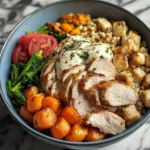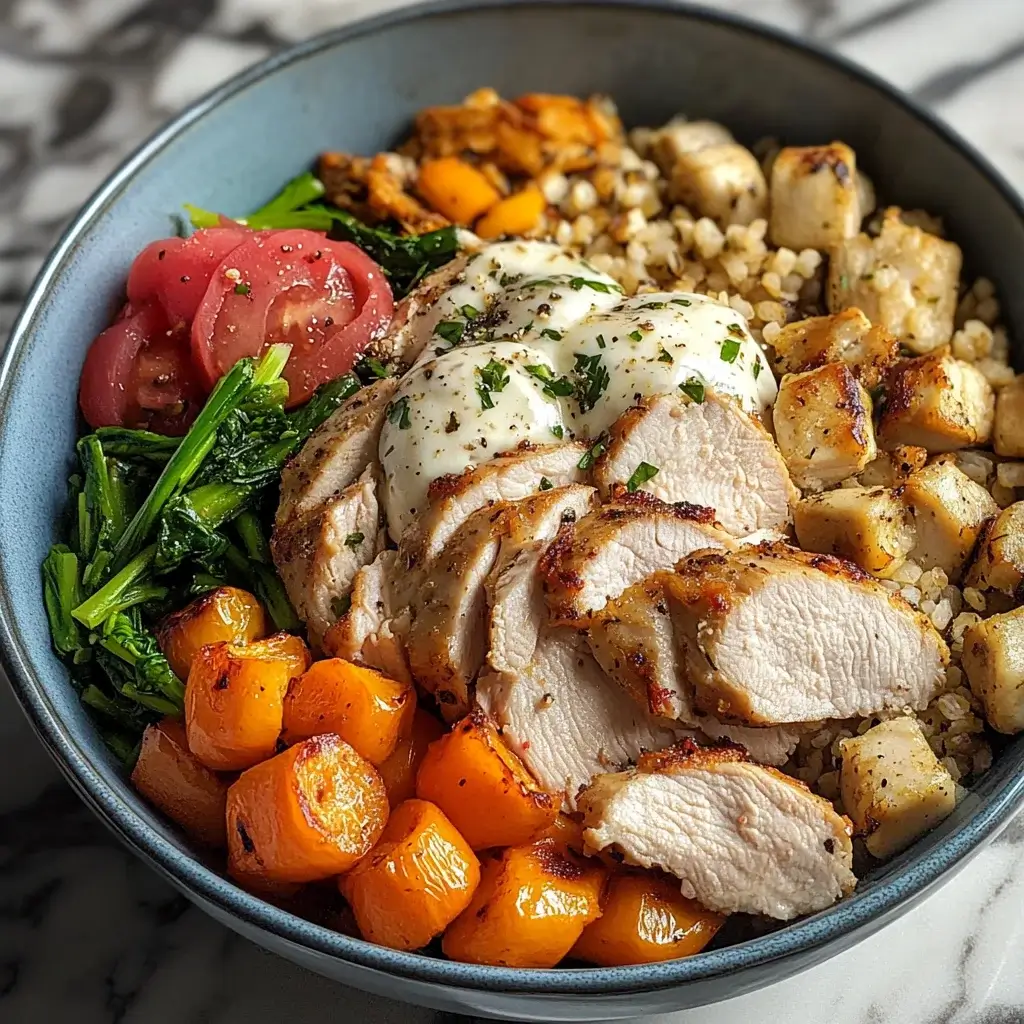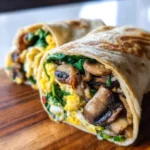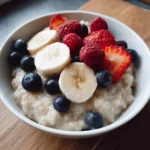Honestly, mornings in our house used to be a bit chaotic. Between getting everyone ready and figuring out a breakfast that wasn’t just cereal again, it felt like a daily struggle. Then there was the perennial question: what to do with that leftover roast chicken from Sunday dinner? Throwing it out felt wasteful, but reheated plain chicken isn’t exactly inspiring. That’s when I stumbled upon the idea of a savory breakfast bowl, and specifically, incorporating that leftover chicken. The first time I made this Leftover Chicken Breakfast Bowl, I was slightly apprehensive – chicken for breakfast? But the reaction was overwhelmingly positive! My partner loved the satisfying protein boost, and even the kids, initially skeptical, were won over by the combination of flavors and textures, especially when they got to customize their toppings. It transformed our mornings from rushed and repetitive to something nourishing, delicious, and incredibly efficient. It utilizes leftovers brilliantly, packs a serious nutritional punch, and keeps us fueled well past lunchtime. It’s become such a staple that sometimes we hope there’s leftover chicken just so we can make these bowls! It’s truly a game-changer for busy families or anyone looking for a hearty, healthy, and waste-reducing start to their day.
Ingredients
- 1 tbsp Olive Oil or Avocado Oil: Used for sautéing vegetables and preventing sticking; choose a quality oil for better flavor and health benefits.
- 1/2 cup Diced Onion: Provides a foundational aromatic flavor base; yellow or white onions work well.
- 1/2 cup Diced Bell Pepper (any color): Adds sweetness, color, and Vitamin C; red, yellow, or orange peppers offer the sweetest taste.
- 1 cup Chopped Spinach or Kale: Boosts nutrient density with vitamins and minerals; wilts down significantly when cooked.
- 1 cup Cooked Leftover Chicken (shredded or diced): The star protein; ensure it’s already cooked (roast, grilled, or boiled chicken works perfectly).
- 1/2 tsp Smoked Paprika: Lends a subtle smoky depth of flavor.
- 1/4 tsp Cumin: Adds a warm, earthy note common in savory dishes.
- Salt and Black Pepper to taste: Essential seasonings to enhance all the flavors.
- 2 Large Eggs: Provide additional protein and richness; cooked to your preference (fried, poached, scrambled).
- Optional Base (choose one, approx 1 cup cooked per serving): Cooked Quinoa, Brown Rice, Sweet Potato Hash, or a bed of Mixed Greens for a lighter option.
- Optional Toppings: Sliced Avocado, Salsa or Pico de Gallo, Plain Greek Yogurt or Sour Cream, Crumbled Feta or Cotija Cheese, Fresh Cilantro or Parsley, Hot Sauce, Toasted Seeds (pumpkin or sunflower).
Instructions
- Prepare Your Base (If Using): If you’re using quinoa, brown rice, or sweet potato hash as a base, ensure it’s cooked and warm before proceeding. If using mixed greens, simply place them in the bottom of your serving bowl.
- Sauté Aromatics: Heat the olive oil or avocado oil in a medium skillet over medium heat. Add the diced onion and cook until softened and translucent, about 3-4 minutes.
- Cook Vegetables: Add the diced bell pepper to the skillet and cook for another 3-5 minutes, until slightly softened but still retaining some bite.
- Wilt Greens: Stir in the chopped spinach or kale. Cook for 1-2 minutes, stirring constantly, until the greens have wilted down significantly.
- Heat the Chicken: Add the cooked, shredded, or diced leftover chicken to the skillet. Stir in the smoked paprika, cumin, salt, and pepper. Cook for 2-3 minutes, stirring frequently, until the chicken is heated through and well combined with the vegetables and spices.
- Cook the Eggs: While the chicken mixture is heating, cook your eggs according to your preference. You can fry them sunny-side up or over-easy in a separate small pan, poach them, or even scramble them. The goal is to have them ready just as the chicken mixture is done.
- Assemble the Bowl: Spoon your chosen base (if using) into a serving bowl. Top the base with the warm chicken and vegetable mixture from the skillet.
- Add the Egg(s): Carefully place your cooked egg(s) on top of the chicken and vegetable layer.
- Garnish and Serve: Add your desired optional toppings. Sliced avocado, a dollop of salsa, a sprinkle of cheese, fresh herbs, or a dash of hot sauce all work beautifully. Serve immediately and enjoy!
Nutrition Facts
- Servings: 1 large bowl (recipe can be easily scaled)
- Calories per Serving: Approximately 450-600 kcal (varies greatly depending on base and toppings used)
- Protein: High (approx. 30-40g) – Primarily from the chicken and eggs, crucial for satiety, muscle maintenance, and providing sustained energy throughout the morning.
(Note: These are estimates. Exact nutritional values depend heavily on specific ingredients, portion sizes, chosen base, and toppings.)
Preparation Time
This Leftover Chicken Breakfast Bowl is designed for speed, especially since the chicken is already cooked.
- Prep Time: Approximately 10 minutes (dicing vegetables, measuring ingredients).
- Cook Time: Approximately 10-15 minutes (sautéing, heating chicken, cooking eggs).
- Total Time: Approximately 20-25 minutes from start to finish, making it a feasible option even on busier mornings.
Why Choose a Savory Breakfast Bowl?
For many, breakfast automatically conjures images of sweet pancakes, sugary cereals, or fruit-laden yogurt. While these can be enjoyable, starting your day with a savory, protein-packed meal like this Leftover Chicken Breakfast Bowl offers distinct advantages.
Firstly, savory breakfasts often provide a more substantial and balanced macronutrient profile. The combination of protein from the chicken and eggs, complex carbohydrates from a base like quinoa or sweet potato, healthy fats from avocado or olive oil, and fiber from the vegetables creates a powerhouse of sustained energy release. Unlike sugary breakfasts that can lead to a quick energy spike followed by a crash, this bowl helps maintain stable blood sugar levels, keeping you feeling full, focused, and energized throughout the morning.
Secondly, incorporating vegetables early in the day is a fantastic way to boost your nutrient intake. Many people struggle to meet their daily vegetable requirements, and adding onions, peppers, and spinach to your breakfast is an easy and delicious step towards that goal. These vegetables provide essential vitamins, minerals, and antioxidants that support overall health.
Finally, breaking away from the sweet breakfast norm can reset your palate and reduce sugar cravings later in the day. Starting with savory flavors can make you feel more satisfied and less likely to reach for sugary snacks mid-morning. This bowl proves that breakfast can be hearty, satisfying, and incredibly flavorful without relying on sugar. It’s a shift towards a more wholesome and fulfilling morning ritual.
The Magic of Leftover Chicken
Leftover cooked chicken is culinary gold, often overlooked or relegated to mundane sandwiches. However, its true magic lies in its versatility and convenience, especially for quick meals like this breakfast bowl. Using pre-cooked chicken drastically cuts down preparation time, transforming a potentially lengthy cooking process into a speedy assembly job.
The beauty of using leftovers extends beyond time-saving. It’s a fantastic strategy for reducing food waste, a significant environmental and economic concern. Giving that delicious roast or grilled chicken a second life in a completely new dish feels both responsible and resourceful. Instead of facing the guilt of discarding perfectly good food, you’re creating another nourishing meal.
Furthermore, leftover chicken often carries residual flavors from its initial preparation – herbs, spices, smokiness from grilling, or the savory depth of roasting. These existing flavors add an extra layer of complexity to the breakfast bowl with minimal effort. Whether it’s lemon-herb roasted chicken, spicy grilled chicken, or simple shredded boiled chicken, each type brings its unique character to the dish, making every bowl potentially different and exciting. Embracing leftover chicken isn’t just practical; it’s a smart, sustainable, and flavorful approach to cooking.
Customizing Your Chicken Breakfast Bowl
One of the greatest strengths of this Leftover Chicken Breakfast Bowl is its sheer adaptability. Think of the recipe as a template, a starting point for your own culinary creativity based on your preferences, dietary needs, or simply what you have on hand.
- Base Variations: While quinoa, brown rice, or sweet potato hash are excellent choices, don’t limit yourself. Consider using farro, barley, cauliflower rice (for a low-carb option), leftover roasted potatoes, or even just a generous bed of sautéed greens like Swiss chard or collards. Each base brings a different texture and nutritional profile.
- Vegetable Swaps: The onion and pepper combination is classic, but feel free to experiment. Mushrooms, zucchini, cherry tomatoes (added towards the end), broccoli florets, or asparagus would all work beautifully. Use seasonal vegetables for the freshest flavors. Consider adding some heat with diced jalapeños or serrano peppers.
- Spice Profiles: Smoked paprika and cumin provide a warm, slightly smoky flavor. Change it up! Try an Italian blend with oregano and basil, a Mexican-inspired mix with chili powder and a pinch of cayenne, or an Indian twist with garam masala and turmeric. A dash of garlic powder or onion powder always enhances savory notes.
- Protein Power-Ups: While chicken is the star, you can supplement or swap. Add black beans or chickpeas along with the chicken for extra fiber and plant-based protein. If you don’t have chicken, leftover turkey, cooked sausage, or even crumbled bacon could work. For a vegetarian version, substitute baked tofu, tempeh, or extra beans.
- Sauce Sensations: The toppings are where you can really personalize. Beyond salsa or hot sauce, consider a drizzle of pesto, a spoonful of hummus, a tangy vinaigrette, creamy chipotle sauce, or even a savory tahini dressing. Sauces tie all the flavors together and add moisture.
- Finishing Touches: Don’t underestimate the power of garnishes. Beyond cilantro or parsley, try fresh dill, chives, or green onions. Toasted nuts (almonds, walnuts) or seeds (hemp, chia, flax) add crunch and healthy fats. A squeeze of fresh lime or lemon juice at the end brightens all the flavors.
Embrace experimentation! Mix and match components to discover your perfect Leftover Chicken Breakfast Bowl combination.
Making it a Balanced Meal
This Leftover Chicken Breakfast Bowl isn’t just delicious and convenient; it’s structured to be a nutritionally balanced powerhouse, setting you up for a productive day. Understanding the role of each component helps appreciate its value.
- Protein Power: Chicken and eggs are the primary protein sources here. Protein is vital for building and repairing tissues, producing enzymes and hormones, and is crucial for satiety. Starting your day with adequate protein helps curb mid-morning hunger pangs and supports stable energy levels.
- Complex Carbohydrates (Energy): Your chosen base (quinoa, brown rice, sweet potato) provides complex carbohydrates. Unlike simple sugars that cause energy spikes and crashes, complex carbs are digested more slowly, offering a steady release of glucose into the bloodstream for sustained energy. They also provide fiber. If you opt for a base of greens, you’re getting fewer carbs but maximizing vitamin and mineral intake.
- Healthy Fats (Nutrient Absorption & More): Fats from the cooking oil (preferably olive or avocado oil), egg yolks, and optional toppings like avocado or seeds are essential. Healthy fats are necessary for absorbing fat-soluble vitamins (A, D, E, K), supporting brain health, and providing another source of long-lasting energy. They also contribute significantly to the feeling of fullness.
- Fiber & Micronutrients (Overall Health): The vegetables (onions, peppers, spinach/kale) and whole-grain bases are packed with dietary fiber. Fiber aids digestion, helps regulate blood sugar, and contributes to satiety. Furthermore, these plant-based components deliver a wealth of essential vitamins (like Vitamin C from peppers, Vitamin K and A from leafy greens) and minerals (like potassium and iron) that support countless bodily functions.
By combining these elements – protein, complex carbs, healthy fats, and fiber-rich vegetables – this breakfast bowl provides a well-rounded nutritional profile. It delivers sustained energy, promotes fullness, supports muscle health, and contributes significantly to your daily intake of essential nutrients, making it an intelligent and wholesome way to begin your day.
How to Serve
Presentation can enhance the enjoyment of any meal, even a quick breakfast bowl. Here are some ways to serve your Leftover Chicken Breakfast Bowl:
- Classic Bowl: Serve in a wide, shallow bowl to allow all the ingredients to be visible and easily accessible.
- Layered Look: Carefully layer the ingredients – base first, then the chicken and vegetable mixture, followed by the egg, and finally the toppings – for an aesthetically pleasing presentation.
- Deconstructed Plate (for picky eaters): Arrange the components separately on a plate – a pile of the chicken mixture, the egg on the side, base in a section, and toppings in small piles or ramekins. This allows individuals to mix and match as they please.
- Garnish Generously: Don’t skip the final touches!
- Fresh Herbs: A sprinkle of chopped cilantro, parsley, chives, or green onions adds freshness and color.
- Creamy Element: A dollop of Greek yogurt, sour cream, or mashed avocado provides a cool, creamy contrast.
- Crunch: Toasted pumpkin seeds, sunflower seeds, or even a few crushed tortilla chips add textural interest.
- Acidity/Heat: A spoonful of salsa, pico de gallo, or your favorite hot sauce brightens flavors and adds a kick. A squeeze of lime is also excellent.
- Cheese: Crumbled feta, cotija, or shredded cheddar/Monterey Jack adds saltiness and richness.
- Pairing Suggestions:
- Serve with a side of fresh fruit for a touch of sweetness.
- A small glass of orange juice or a cup of coffee or tea complements the savory flavors well.
Additional Tips
- Meal Prep Magic: Save even more time by prepping components in advance. Dice onions and peppers and store them in an airtight container in the fridge. Cook a batch of your chosen base (quinoa/rice) ahead of time. You can even pre-shred or dice the leftover chicken. Assembly then takes mere minutes.
- Spice It Up Your Way: Feel free to adjust the seasonings. Add garlic powder, onion powder, chili powder for more heat, or even a pinch of curry powder for a different flavor profile. Don’t be afraid to experiment beyond paprika and cumin.
- Veggie Variety: Use this bowl as a way to clear out your vegetable drawer! Sliced mushrooms, chopped zucchini, corn kernels, or even leftover roasted vegetables can be added to the skillet along with the peppers and onions.
- Chicken Choices: While leftover roast chicken is ideal, almost any cooked chicken works. Grilled chicken adds a smoky flavor, shredded rotisserie chicken is super convenient, and even plain boiled chicken gets a new life here.
- Make it Low-Carb/Keto: Skip the grain base and serve the chicken, vegetable, and egg mixture over a bed of fresh spinach, arugula, or cauliflower rice. Ensure toppings like avocado and cheese fit your macros.
- Egg Excellence: The way you cook your egg matters! A runny yolk (from a sunny-side-up or poached egg) creates a delicious sauce that coats the other ingredients. If you prefer scrambled, cook them just before serving so they stay moist.
- Storage and Reheating: Store leftover assembled bowls (without runny eggs or avocado) in an airtight container in the refrigerator for up to 2 days. Reheat gently in the microwave or on the stovetop. It’s often best to cook the egg fresh just before serving leftovers. The chicken/veg mixture reheats very well.
- Kid-Friendly Customization: Let kids build their own bowls! Set out the base, chicken mixture, cooked eggs (maybe scrambled is easier for little ones), and a variety of mild toppings like shredded cheese, plain yogurt, and maybe some corn or black beans.
FAQ Section
- Q: Can I use freshly cooked chicken instead of leftover chicken?
A: Absolutely! If you don’t have leftovers, simply cook about 4-6 oz of chicken breast or thigh (diced or sliced) in the skillet before you sauté the onions. Season it well and cook through, then remove it from the skillet, proceed with the veggies, and add the cooked chicken back in step 5. This will add about 5-7 minutes to the cooking time. - Q: What are some good gluten-free base options?
A: Quinoa, brown rice, certified gluten-free oats (prepared savory-style), sweet potato hash, cauliflower rice, or simply a bed of mixed greens are all excellent gluten-free choices for this breakfast bowl. - Q: Can I make this recipe vegetarian or vegan?
A: Yes! For a vegetarian version, omit the chicken and substitute with black beans, chickpeas, crumbled pan-fried tofu, or tempeh. Ensure you season the substitute well. For a vegan version, do the vegetarian substitution and replace the egg with a tofu scramble, more beans, or simply extra avocado and veggies. Use plant-based yogurt/sour cream alternatives for toppings. - Q: How long can I store the cooked chicken and vegetable mixture?
A: The cooked chicken and vegetable mixture (without the egg or base) can be stored in an airtight container in the refrigerator for up to 3-4 days. This makes it great for meal prepping multiple breakfasts. - Q: My base (quinoa/rice) gets soggy when I assemble the bowl ahead of time. Any tips?
A: To prevent sogginess, store the base separately from the chicken/vegetable mixture and the toppings. Assemble the bowl just before serving or reheating. Alternatively, use a heartier base like sweet potato hash which holds up better. - Q: Can I use different types of leftover meat?
A: Certainly! Leftover cooked turkey works perfectly as a direct substitute for chicken. Leftover pulled pork, shredded beef, or even cooked sausage could also be delicious variations, though they will change the flavor profile significantly. - Q: What’s the best way to reheat a pre-assembled bowl?
A: Reheat gently to avoid overcooking the egg (if included) and drying out the chicken. Microwaving on medium power in 30-second intervals, stirring in between, works well. Alternatively, you can transfer the bowl contents (minus fresh toppings like avocado) to a skillet and reheat over medium-low heat, adding a splash of water or broth if it seems dry. Cooking a fresh egg is often preferred when reheating. - Q: My bowl tastes a bit bland. How can I easily boost the flavor?
A: Flavor boosting is easy! Ensure you’ve seasoned adequately with salt and pepper. Increase the amount of smoked paprika and cumin, or add other spices like garlic powder or chili powder. Don’t underestimate toppings – a flavorful salsa, a tangy hot sauce, fresh herbs (cilantro!), a squeeze of lime juice, or salty feta cheese can dramatically elevate the taste.

Leftover Chicken Breakfast Bowl
Ingredients
- 1 tbsp Olive Oil or Avocado Oil: Used for sautéing vegetables and preventing sticking; choose a quality oil for better flavor and health benefits.
- 1/2 cup Diced Onion: Provides a foundational aromatic flavor base; yellow or white onions work well.
- 1/2 cup Diced Bell Pepper (any color): Adds sweetness, color, and Vitamin C; red, yellow, or orange peppers offer the sweetest taste.
- 1 cup Chopped Spinach or Kale: Boosts nutrient density with vitamins and minerals; wilts down significantly when cooked.
- 1 cup Cooked Leftover Chicken (shredded or diced): The star protein; ensure it’s already cooked (roast, grilled, or boiled chicken works perfectly).
- 1/2 tsp Smoked Paprika: Lends a subtle smoky depth of flavor.
- 1/4 tsp Cumin: Adds a warm, earthy note common in savory dishes.
- Salt and Black Pepper to taste: Essential seasonings to enhance all the flavors.
- 2 Large Eggs: Provide additional protein and richness; cooked to your preference (fried, poached, scrambled).
- Optional Base (choose one, approx 1 cup cooked per serving): Cooked Quinoa, Brown Rice, Sweet Potato Hash, or a bed of Mixed Greens for a lighter option.
- Optional Toppings: Sliced Avocado, Salsa or Pico de Gallo, Plain Greek Yogurt or Sour Cream, Crumbled Feta or Cotija Cheese, Fresh Cilantro or Parsley, Hot Sauce, Toasted Seeds (pumpkin or sunflower).
Instructions
- Prepare Your Base (If Using): If you’re using quinoa, brown rice, or sweet potato hash as a base, ensure it’s cooked and warm before proceeding. If using mixed greens, simply place them in the bottom of your serving bowl.
- Sauté Aromatics: Heat the olive oil or avocado oil in a medium skillet over medium heat. Add the diced onion and cook until softened and translucent, about 3-4 minutes.
- Cook Vegetables: Add the diced bell pepper to the skillet and cook for another 3-5 minutes, until slightly softened but still retaining some bite.
- Wilt Greens: Stir in the chopped spinach or kale. Cook for 1-2 minutes, stirring constantly, until the greens have wilted down significantly.
- Heat the Chicken: Add the cooked, shredded, or diced leftover chicken to the skillet. Stir in the smoked paprika, cumin, salt, and pepper. Cook for 2-3 minutes, stirring frequently, until the chicken is heated through and well combined with the vegetables and spices.
- Cook the Eggs: While the chicken mixture is heating, cook your eggs according to your preference. You can fry them sunny-side up or over-easy in a separate small pan, poach them, or even scramble them. The goal is to have them ready just as the chicken mixture is done.
- Assemble the Bowl: Spoon your chosen base (if using) into a serving bowl. Top the base with the warm chicken and vegetable mixture from the skillet.
- Add the Egg(s): Carefully place your cooked egg(s) on top of the chicken and vegetable layer.
- Garnish and Serve: Add your desired optional toppings. Sliced avocado, a dollop of salsa, a sprinkle of cheese, fresh herbs, or a dash of hot sauce all work beautifully. Serve immediately and enjoy!
Nutrition
- Serving Size: one normal portion
- Calories: 600
- Protein: 40g






